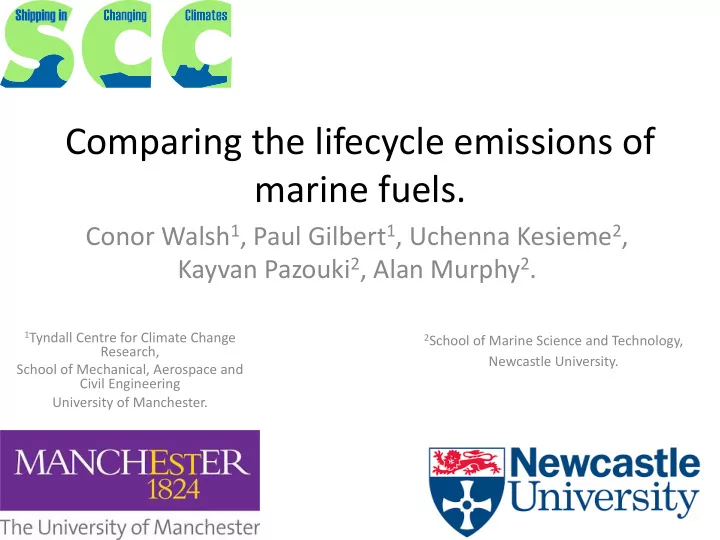

Comparing the lifecycle emissions of marine fuels. Conor Walsh 1 , Paul Gilbert 1 , Uchenna Kesieme 2 , Kayvan Pazouki 2 , Alan Murphy 2 . 1 Tyndall Centre for Climate Change 2 School of Marine Science and Technology, Research, Newcastle University. School of Mechanical, Aerospace and Civil Engineering University of Manchester.
Talk Outline • IntroducLon • Aims • Scope and Methodology • Results • Discussion & Conclusion
IntroducLon • Within a 2°C framing all sectors face a common onus to decarbonise by 2050. – Dependent on demand but a > 80% decrease in carbon intensity (per tonne km) of shipping is foreseen. • Several miLgaLon measures suggested. – OperaLonal measures such as speed reducLon. – New build and retrofit technologies. • Fuel switching also idenLfied as a potenLally important contributor to emission reducLons.
IntroducLon • Fuel switching can appear parLcularly aYracLve. – E.g. Hydrogen zero carbon emissions? – Important for emission scenarios. • However many fuels embody significant emissions in their producLon. • Need to generate emission esLmates that reflect the enLre fuel-cycle. – Inform wider scenario work, i.e. GloTraM. – Reflect wider sectoral change and important sensiLviLes. – Move beyond “snap shots”.
Lifecycle Assessment (LCA) Aims • Generate upstream and operaLonal emission esLmates for a range of marine fuels. – Reflect establishing and emerging fuels. – Present results that are compaLble with exisLng tools. – IdenLfy important sensiLviLes in the elements that determine upstream emissions.
SCOPE AND METHODOLOGY
Scope and Methodology Fuel and Engines LCA Structure Fuel Engine Region Heavy Fuel Oil Slow Diesel Europe, with average crude Marine Diesel Oil Medium import mix Biodiesel Speed Diesel (Bio)LNG Spark Europe, LaLn IgniLon Gas America, Liquid Hydrogen Fuel Cell USA, Europe (fossil and renewable, w/o CCS) Methanol Dual Fuel Europe engines Straight vegetable Oil Slow Diesel LaLn America, Europe
Scope and Methodology A?ribuAonal LCA • Linked lifecycle Emissions Stage 1 Energy & stages. e.g. extracLon Materials – ExtracLon to Process combusLon. inputs to – Biogenic CO 2 Stage 2 excluded. Emissions Energy & Stage 2 • Results expressed in Materials e.g. processing mulLple units. Process – Kg/kg fuel. inputs to – Kg/kWh (shae). Stage 3
RESULTS
Baseline Results • For each fuel a baseline value is presented reflecLng current (2010) technology. – Focus on green house gases (GHGs). – Reflects established technology. – E.g. Marine diesel based on European disLllery configuraLon. • Results expressed in CO 2 equivalents. – GWP (100 years) from AR5.
Lifecycle GHG emissions by mass of fuel (exc. operaAonal biogenic CO 2 ) By lifecycle stage By emission species 20 20 18 18 16 16 14 14 kg CO 2 e/kg kg CO 2 e/kg 12 12 10 10 8 8 6 6 4 4 2 2 0 0 OperaAonal Upstream CO2 CH4 N2O
Lifecycle GHG emissions by engine work (exc. operaAonal biogenic CO 2 ) By lifecycle stage Impact of engine type • Arguably a more meaningful 1,200 comparator of fuels. 1,000 • Reflects the impact of engine g CO 2 e/kWh 800 efficiency and energy content. 600 – LH 2 (high emissions, low SFC). 400 – MeOH (low emissions, high SFC). 200 0 HFO MDO LNG LH2 (no CCS) MeOH Bio-LNG LH2 (CCS) Re LH2 Soy SVO (ex LUC) Soy BD (ex LUC) Rape SVO (ex LUC) Rape BD (ex LUC) OperaAonal Upstream
DISCUSSION
Discussion • Results demonstrate comparable emissions for established marine fuels. • LNG not a low GHG opLon. – Especially if higher venLng, flaring, in-process use and methane slips are considered. – Biofuels demonstrate higher upstream emissions. • ExaminaLon of lifecycle ‘hot spots’ allows for hypotheLcal modificaLon of important sensiLviLes.
Fuel-cycle sensiLviLes • 2 examples Comparison of upstream emissions 800 700 1. LH 2 with renewable 600 electricity, gaseous g CO 2 e/kWh 500 feedstock, and increased 400 (95%) CCS capture rate. 300 200 2. Soy derived bio-diesel 100 including impact of land 0 use change. LH2 (CCS) LH2 (Hi eff Soy BD (exl Soy BD (incl CCS, LUC) LUC) renewable grid)
Discussion • Important to consider the units and system boundary when presenLng and comparing lifecycle emissions. • Risk of misrepresentaLon of results. – Especially when comparing fuels with different fuel cycle characterisLcs.
Importance of Units • Example; MDO, LNG, LH 2 Comparison of fuel-cycle GHG emissions – Compared based on 300 mass, fuel energy content and shae energy. 250 200 • Comparison of LH 2 with 150 other fuels dependent on system boundary and 100 units. 50 • Also remember increase 0 kg per kg fuel g per MJ fuel g per MJ sha_ in GWP for CH 4 (AR5). MDO LNG LH2 (no CCS)
Conclusions • Results demonstrate that significant emission reducLons are difficult to achieve by fuel switching alone. – Low carbon fuels (LH 2 and biofuels) entail challenges. • However drasLc emission reducLons in the shipping sector can coincide with system level efforts such as grid decarbonisaLon.
Thank You Tyndall Centre for Climate Change School of Marine Science and Technology, Research, Newcastle University. School of Mechanical, Aerospace and Civil Engineering University of Manchester.
Recommend
More recommend